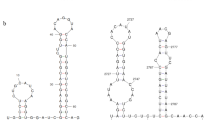Abstract
A double-stranded RNA (dsRNA) segment was identified in Rhizoctonia solani anastomosis group (AG)-2-2IIIB, the primary causal agent of Rhizoctonia crown and root rot of sugar beet. The dsRNA segment represented the genome replication intermediate of a new mitovirus that was tentatively designated as "Rhizoctonia solani mitovirus 39" (RsMV-39). The complete sequence of the dsRNA was 2805 bp in length with 61.9% A+U content. Using either the fungal mitochondrial or universal genetic code, a protein of 840 amino acids containing an RNA-dependent RNA polymerase (RdRp) domain was predicted with a molecular mass of 94.46 kDa. BLASTp analysis revealed that the RdRp domain of RsMV-39 had 43.55% to 72.96% sequence identity to viruses in the genus Mitovirus, and was the most similar (72.96% identical) to that of Ceratobasidium mitovirus A (CbMV-A). Phylogenetic analysis based on RdRp domains clearly showed that RsMV-39 is a member of a distinct species in the genus Mitovirus of the family Mitoviridae. This is the first full genome sequence of a mycovirus associated with R. solani AG-2-2IIIB.


Similar content being viewed by others
References
Stevanato P, Chiodi C, Broccanello C, Concheri G, Biancardi E, Pavli O, Skaracis G (2019) Sustainability of the sugar beet crop. Sugar Technol 21:703–716
Strausbaugh CA, Eujayl IA, Panella LW (2013) Interaction of sugar beet host resistance and Rhizoctonia solani AG-2-2 IIIB strains. Plant Dis 97:1175–1180
Zhao C, Wu X (2014) First report of sugar beet Rhizoctonia crown and root rot caused by Rhizoctonia solani AG-2-2IIIB in Shanxi province of China. Plant Dis 98:419
Xu Z, Wu S, Liu L, Cheng J, Fu Y, Jiang D, Xie J (2015) A mitovirus related to plant mitochondrial gene confers hypovirulence on the phytopathogenic fungus Sclerotinia sclerotiorum. Virus Res 197:127–136
Ghabrial SA, Suzuki N (2009) Viruses of plant pathogenic fungi. Annu Rev Phytopathol 47:353–384
Ghabrial SA, Castón JR, Jiang D, Nibert ML, Suzuki N (2015) 50-plus years of fungal viruses. Virology 479:356–368
Chen Y, Shang H, Yang H, Gao B, Zhong J (2017) A mitovirus isolated from the phytopathogenic fungus Alternaria brassicicola. Arch Virol 162:2869–2874
Abdoulaye AH, Foda MF, Loizou IK (2019) Viruses infecting the plant pathogenic fungus Rhizoctonia solani. Viruses 11:1113
Hillman BI, Esteban R (2011) Narnaviridae. In: King AMQ, Adams MJ, Carstens EB, Lefkowitz EJ (eds) Virus taxonomy: classification and nomenclature of viruses: Ninth Report of the International Committee on Taxonomy of Viruses. Elsevier, San Diego, pp 1055–1060
Zhang T, Li W, Chen H, Yu H (2015) Full genome sequence of a putative novel mitovirus isolated from Rhizoctonia cerealis. Arch Virol 160:1815–1818
Abdoulaye AH, Cheng J, Fu Y, Jiang D, Xie J (2017) Complete genome sequence of a novel mitovirus from the phytopathogenic fungus Rhizoctonia oryzae-sativae. Arch Virol 162:1409–1412
Das S, Falloon RE, Stewart A, Pitman AR (2016) Novel mitoviruses in Rhizoctonia solani AG-3PT infecting potato. Fungal Biol 120:338–350
Bartholomäus A, Wibberg D, Winkler A, Pühler A, Schlüter A, Varrelmann M (2016) Deep sequencing analysis reveals the mycoviral diversity of the virome of an avirulent isolate of Rhizoctonia solani AG-2-2 IV. PLoS ONE 11:e0165965
Hillman BI, Cai G (2013) Chapter six-the family Narnaviridae: simplest of RNA viruses. Adv Virus Res 86:149–176
Deng F, Boland GJ (2006) Attenuation of virulence in Sclerotinia homoeocarpa during storage is associated with latent infection by Ophiostoma mitovirus 3a. Eur J Plant Pathol 114:127–137
Sahin E, Akata I (2019) Complete genome sequence of a novel mitovirus from the ectomycorrhizal fungus Geopora sumneriana. Arch Virol 164:2853–2857
Zheng L, Zhao J, Liang X, Zhuang H, Qi T, Kang Z (2019) Complete genome sequence of a novel mitovirus from the wheat stripe rust fungus Puccinia striiformis. Arch Virol 164:897–901
Ran H, Liu L, Li B, Cheng J, Fu Y, Jiang D, Xie J (2016) Co-infection of a hypovirulent isolate of Sclerotinia sclerotiorum with a new botybirnavirus and a strain of a mitovirus. Virol J 13:92
Khalifa ME, Pearson MN (2013) Molecular characterization of three mitoviruses co-infecting a hypovirulent isolate of Sclerotinia sclerotiorum fungus. Virology 441:22–30
Wu M, Zhang L, Li G, Jiang D, Ghabrial SA (2010) Genome characterization of a debilitation-associated mitovirus infecting the phytopathogenic fungus Botrytis cinerea. Virology 406:117–126
Ma G, Liang Z, Hua H, Zhou T, Wu X (2019) Complete genome sequence of a new botybirnavirus isolated from a phytopathogenic Alternaria alternata in China. Arch Virol 164:1225–1228
Morris TJ, Dodds JA (1979) Isolation and analysis of double-stranded RNA from virus-infected plant and fungal tissue. Phytopathology 69:854–858
Tamura K, Peterson D, Peterson N, Stecher G, Nei M, Kumar S (2011) MEGA5: molecular evolutionary genetics analysis using maximum likelihood, evolutionary distance, and maximum parsimony methods. Mol Biol Evol 28:2731–2739
Funding
This work was financially supported by the Earmarked Fund for China Agriculture Research System (CARS-170304) and the National Training Program of Innovation and Entrepreneurship for Undergraduates (201910019031).
Author information
Authors and Affiliations
Corresponding authors
Ethics declarations
Conflict of interest
The authors declare that they have no conflict of interest.
Ethical approval
This study did not include experiments with human participants or animals performed by any of the authors.
Additional information
Handling Editor: Ioly Kotta-Loizou.
Publisher's Note
Springer Nature remains neutral with regard to jurisdictional claims in published maps and institutional affiliations.
Electronic supplementary material
Below is the link to the electronic supplementary material.
Rights and permissions
About this article
Cite this article
Li, S., Li, Y., Hu, C. et al. Full genome sequence of a new mitovirus from the phytopathogenic fungus Rhizoctonia solani. Arch Virol 165, 1719–1723 (2020). https://doi.org/10.1007/s00705-020-04664-w
Received:
Accepted:
Published:
Issue Date:
DOI: https://doi.org/10.1007/s00705-020-04664-w




